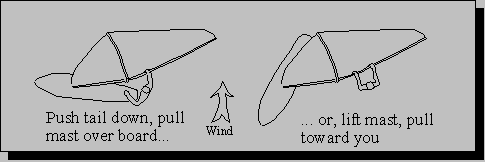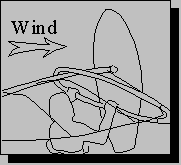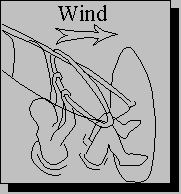Water Starts
Water starting is a lot less work than up hauling.
You need a lot of wind (over 12 knots) and a big sail (at least 5.8 m2 for the average person) to learn to water start easily.
Wear a life jacket, and tie it to your harness (around your waist) to keep it from riding up. This will make it easier to hold the sail out of the water.
Move the boom a bit lower on the mast than you normally would. This will help you to get the sail up high.
Start WAY upwind, at the west edge of the Junior area. The wind is strongest here, and you'll be going downwind all the time you are trying to waterstart.
Get the mast in position
Begin with the mast at almost 90 degrees to the wind, with the mast tip slightly downwind of the mast base.
Don't struggle with the sail to position the mast, just swim it around slowly. Use the wind to flip the sail over if the clew is upwind of the mast--lift the clew up sharply and let go and the sail will flip over. Let the sail float to the top of the water.
Lift the mast to get the sail out of the water

If the mast ends up downwind of the board, push the tail of the board down while pulling on the mast to bring the boom up onto the tail of the board, and the sail will break free of the water. Don't pull on the boom, or the clew of the sail will sink.
Or, if the mast ends up upwind of the board (as shown at right in the diagram), grab the mast with both hands about 3 feet towards the tip from the boom. Lift the mast up and pull it towards you to allow the wind to get under the sail.
Force the mast forward
When the sail is out of the water, transfer the hand that is closest to the mast tip onto the boom. This is now your aft hand for sailing. Pull towards you with your aft hand to force the mast toward the nose of the board. This will force the board forward, so that it points on a beam reach. Don't pull down with your aft hand (which sheets in the sail) so much that you are drawn out of the water.
 Get close to the board
Get close to the board
Kick with your legs, moving them as if riding a bicycle, to get your body close to the board. Move the other hand to the boom, and keep forcing the mast forward just enough to keep the board on a close reach. If you don't force the mast forward enough, the board will turn up into the wind. Don't pull down with that aft hand too much, or the sail will pull the mast backward, and the board will turn into the wind. The sail should be just supporting its own weight, not pulling you out of the water as you kick alongside the board.
Get your foot (or feet) onto the board
 When you get close enough, lift one or both legs onto the board and you are now sailing with your butt in the water. Force the mast toward the nose enough to get
the board on a close reach to a beam reach; tip the mast back toward the tail if the board falls off to a broad reach. Wiggle your feet over to the middle of the board. If you have one
foot in the water, kick hard to help yourself up.
When you get close enough, lift one or both legs onto the board and you are now sailing with your butt in the water. Force the mast toward the nose enough to get
the board on a close reach to a beam reach; tip the mast back toward the tail if the board falls off to a broad reach. Wiggle your feet over to the middle of the board. If you have one
foot in the water, kick hard to help yourself up.
Get up and sail off!
Only when you are in position to get up onto the board should you sheet in to pull yourself up onto the board. If the wind doesn't yank you out of the water as soon as you sheet in, crunch your body by bending your knee(s) and bending at the waist to get your head as close to the universal as you can. Your arms should be straight up, pulling downward on the boom as you rise up above the board.
As you get your weight above the board, stay VERY low by bending your knees. Once you get vertical, TIP THE MAST FORWARD HARD, so you don't round up, and SHEET OUT so you don't go over the other side and back into the drink. You're off!
TROUBLESHOOTING
The mast ends up near the nose, not the tail of the board -- Swim it around slowly, or lift it out of the water, as if the nose were the tail and you were water starting, and flip it over towards the tail.
The sail pushed my head down -- You let the mast base get upwind of the mast tip. Push down on the mast base to keep the board from rounding up and to keep the mast tip upwind of the base.
The sail got wrenched out of my hands -- You sheeted in too hard and/or too soon. Wait until you're ready to get up onto the board before you sheet in, and do so judiciously.
The ail flopped over towards the board's nose -- You pushed the mast base too far downwind and forced the mast tip too far upwind
The board sails away from me before I can get on -- Kick harder in the water and don't sheet in so hard on the sail.
I couldn't get up onto the board -- You needed more wind and/or a bigger sail, or you need to crunch yourself in closer to the board while extending your arms to lift the sail higher.
The board always rounds up when I try to put my foot on the board -- 1) start with the board pointing more downwind, and 2) at the instant you put your foot up move the sail WAY forward with a big and quick movement to keep the board from rounding up. Once off the wind again you can move the sail back to the neutral-flying position.
I got catapulted over the board -- Don't sheet in so hard, and keep in a squat as you rise onto the board so you won't need so much sail force, and remember to sheet out as you get up so you won't get blown over.
I always end up way downwind -- Start practicing next to Hs. Lordships (the restaurant at the point) and then uphaul when you're blown down so that you're even with middle dock.
I got so tired I couldn't even uphaul to get back -- Don't panic. Even if you die out there, you won't go to waste. We're lighting the barbecue back at the clubhouse.
Advanced
Once you get onto a short board, it's a lot easier to water start because the board, being smaller, is easier to position in the water.
A better way to get the sail out of the water: Start with the sail positioned in the water with its clew downwind of its mast, and the mast tip slightly downwind of the mast base, like either of the positions in the first figure. You float alongside the sail , facing the mast base. Reach over your head with your right arm and grab the MAST about a foot above the boom clamp. Quickly, pull the MAST with your right hand over your head and toward windward. At the same time reach down with your left hand and grab the boom behind the harness strap and pull toward you. You are NOT lifting the sail up, rather slicing it out of the water toward windward.
When you get up onto the board, try to step up onto it rather than relying on the wind to lift you on board. Push the sail all the way up with arms fully extended, like you are trying to place the boom on a high shelf. Then step up by kicking hard with one foot in the water as you push down on the board with the other foot. Imagine you are trying to climb onto a boat quickly because there is a shark in the water.





